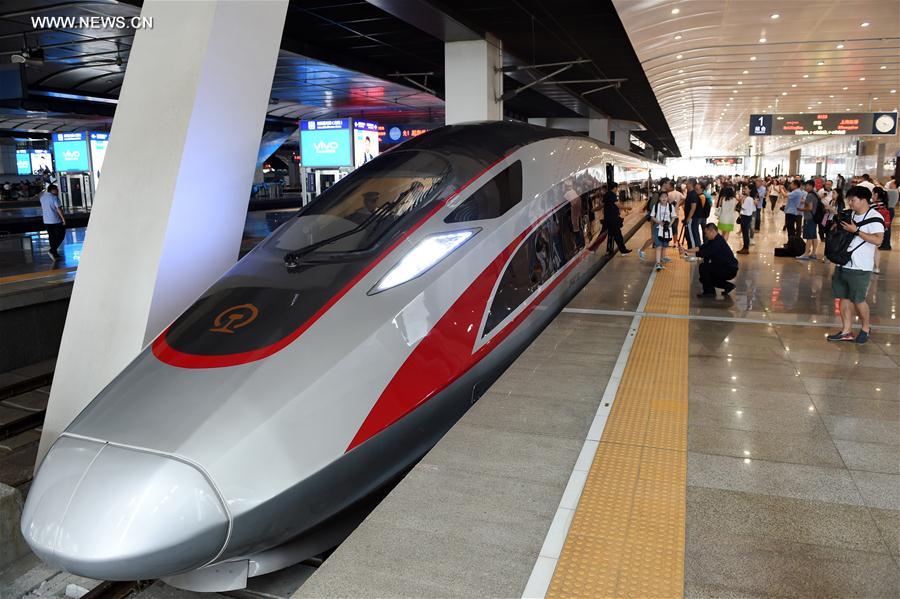
Photo taken on June 26, 2017 shows the China's new bullet train "Fuxing" at Beijing South Railway Station in Beijing, capital of China. China's next generation bullet train "Fuxing" debuted on the Beijing-Shanghai line on Monday. A CR400AF model departed Beijing South Railway Station at 11:05 a.m. for Shanghai. At the same time, the CR400BF model left Shanghai Hongqiao Railway Station for Beijing. The new bullet trains, also known as electric multiple units (EMU), boast top speeds of 400 kilometers an hour and a consistent speed of 350 kilometers an hour. (Xinhua/Ju Huanzong)
BEIJING, June 26 (Xinhua) -- The launch on Monday of two-way traffic of the "Fuxing" (Renaissance) class bullet train between Beijing and Shanghai has once again drawn widespread attention to China's rapidly developing and advanced high speed rail technology.
With the intellectual property rights fully owned by China, the latest version of the "China Standards" bullet train highlights not only products that are China-made, but also China-designed.
The International Union of Railways code puts high speed rail transport at at least 200 km per hour for upgraded rails, or 250 km to 300 km per hour for newly-built rails. China, with many world records, is a newcomer coming to the fore in this sector.
STARTING IN JAPAN
The world's first commercially operated high speed rail appeared in Japan in October 1964. Known as Shinkansen (The New Trunk Line) in the East Asian country, its service was first launched between Tokyo and Shin-Osaka ahead of the 1964 Tokyo Olympics.
Currently, Japan's Shinkansen mileage totals close to 2,765 km, and, excluding the Mini-Shinkansen, the highest operating speeds for different lines there stand between 240 km to 320 km per hour.
Japan's Shinkansen train features electric multiple units with self-propelled carriages instead of locomotive pulling. The technology enables more comfortable a ride for passengers with the train running more smoothly and quietly.
In addition, Japanese researchers believe that for one-way traffic of more than five hours, high speed rail would lose advantage to air travel.
New railway building in Japan helped push the growth in industries such as civil construction and manufacturing, promote personnel movement, boost local economic development and diminish disparity between cities and countries.
FLOURISHING IN EUROPE
At the time when Japan was constructing Shinkansen, Europe and America treated rail transport as a sunset industry and highlighted highway transport and air transport. However, the success of Shinkansen shocked European countries and they started to catch up, especially France and Germany.
The bright orange TGV (train a grande vitesse) high speed train brought into service from Paris to Lyon on September 17, 1981. It soon rose to fame as the first and only high speed train in Europe.
France's high speed rail paid off its cost within only 10 years and became a representative of high technology in France. By 2014, the total length of France's high-speed rails reached 2,037 km. France also set the record of the highest speed of high speed rails many times.
The quantity of France's high speed rails ranks Europe's first and world's second. France also exported high speed rail technology, but the result, however, was not as well as expected because of high pricing.
France used to took an active part in tendering for high speed rail projects in South Korea, Morocco and South America, but the success rate was not high. Analysts said that high pricing was the main reason that limited the export of France's high speed rails.
Germany's high speed rail is known as Inter-City-Express Train (ICE). In 1991, the first ICE train from Hannover to Wuerzburg was brought into operation. A major feature of the ICE is energy-saving and environmentally friendly.
Data from Deutsche Bahn indicate that the third generation of the ICE is more energy-saving than airplanes and cars. When its passenger rate reaches 50 percent, the fuel consumption per person per kilometer is no more than two liters.
Besides, Germany has constructed many Trans-Europe high speed rails in cooperation with Britain, the Netherlands, Belgium, Switzerland and Austria, through which passengers can travel to many countries.
INNOVATION IN CHINA
Although for Europe and Japan, China is a latecomer in the high speed rail industry, it has been an outstanding example of one who starts late but develops fast, owing to its multiple honors of "the World's No.1," including the world's longest high-speed rail transport operation mileage of 10,000 km and the world's first high speed rail that lies in freezing cold region -- the Harbin-Dalian high speed railway.
The Harbin-Dalian high speed railway was built on frozen soils in Northeast China and has been operating smoothly in temperatures of minus 50 degrees Centigrade.
Under the guidelines of "bringing in advanced technology and creating China's brand," Chinese researchers and developers have managed to learn and integrate foreign technologies and make innovation to roll out China's own brands with new technologies and new standards that finally enable China to surpass Western countries in the high speed rail industry.
Thanks to strong capabilities in manufacturing and construction, Chinese enterprises' construction cost of high speed rails is much lower than that of Western companies. According to a report by BBC in 2014, the construction cost of China's high speed rails per kilometer normally stood between 1.7 million U.S. dollars to 2.1 million, compared with Europe's 2.5 million U.S. dollars to 3.8 million. While in the United States, that figure of cost reached 5.6 million.
In his comments on China's high speed rail technology, Ivan Andrievsky, vice president of Russian Union of Engineers, said that China has developed its own technologies based on the technologies it purchased, which is true innovation instead of copycatting. He stressed that China's key advantages lie in its work speed, pricing, quality and technologies.















